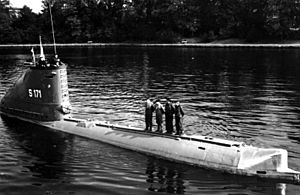German submarine U-2337 facts for kids

Postwar photo of Hecht (S 171), (former Type XXIII submarine U-2367). An identical sister ship of U-2337.
|
|
Quick facts for kids History |
|
|---|---|
| Name | U-2337 |
| Ordered | 20 September 1943 |
| Builder | Deutsche Werft, Hamburg |
| Yard number | 491 |
| Laid down | 2 August 1944 |
| Launched | 15 September 1944 |
| Commissioned | 4 October 1944 |
| Fate |
|
| General characteristics | |
| Class and type | Type XXIII submarine |
| Displacement |
|
| Length |
|
| Beam |
|
| Draught | 3.66 m (12 ft) |
| Installed power |
|
| Propulsion |
|
| Speed |
|
| Range |
|
| Test depth | 180 m (590 ft) |
| Complement | 14–18 |
| Armament |
|
| Service record | |
| Part of: |
|
| Commanders: |
|
| Operations: | None |
| Victories: | None |
The German submarine U-2337 was a special kind of U-boat used by Nazi Germany during World War II. It was a Type XXIII submarine, which was a smaller, faster submarine designed for coastal waters. The U-2337 was ordered in September 1943. It was built in Hamburg and launched in September 1944. The submarine officially joined the German navy on October 4, 1944, under the command of Günter Behnisch.
Contents
Submarine Design and Features
The U-2337 was a compact submarine, weighing about 234 tonnes (230 long tons) when on the surface. When it went underwater, its weight increased slightly to 258 tonnes (254 long tons). It was about 34.68 m (113 ft 9 in) long, which is roughly the length of two school buses. The submarine was 3.02 m (9 ft 11 in) wide and could go 3.66 m (12 ft) deep in the water.
How it Moved
This submarine had a powerful engine system. It used a diesel engine for moving on the surface. When it went underwater, it switched to electric motors. One of these electric motors was designed for "silent running." This meant it could move very quietly, making it harder for enemies to detect.
Speed and Travel Distance
The U-2337 could travel at different speeds depending on whether it was on the surface or submerged.
- On the surface, its top speed was about 9.7 knots (18.0 km/h; 11.2 mph).
- Underwater, it could go faster, reaching speeds of up to 12.5 knots (23.2 km/h; 14.4 mph).
It could travel a long way without needing to refuel.
- On the surface, it could go about 2,600 nautical miles (4,800 km; 3,000 mi) (around 4,800 kilometers) at a speed of 8 knots (15 km/h; 9.2 mph).
- Underwater, it could travel 194 nmi (359 km; 223 mi) (about 360 kilometers) at a slower speed of 4 knots (7.4 km/h; 4.6 mph).
What it Carried
The U-2337 was armed with two torpedo tubes at the front. It could carry two torpedoes, which were powerful underwater weapons. Unlike some larger U-boats, this type of submarine did not have a deck gun. A small crew of 14 to 18 sailors operated the submarine.
Service and Final Fate
The U-2337 did not take part in any major battles during the war. It was part of the 32nd U-boat Flotilla from October 1944 until the end of the war.
Surrender and Sinking
When World War II ended, the U-2337 surrendered to the Allied forces. This happened on May 9, 1945, in Kristiansand, Norway. After its surrender, the submarine was moved to Loch Ryan, Scotland.
The U-2337 was one of many German U-boats that were sunk by the Allies after the war. This event was called Operation Deadlight. The goal was to prevent Germany from using these submarines again. On November 28, 1945, the U-2337 was towed out to sea. It was then sunk by gunfire from two Allied destroyers: the British ship HMS Onslow and the Polish ship ORP Piorun.
Where the Wreck Lies
Today, the wreck of the U-2337 rests at the bottom of the ocean. Its location is 56°10′N 10°05′W / 56.167°N 10.083°W.
See also

